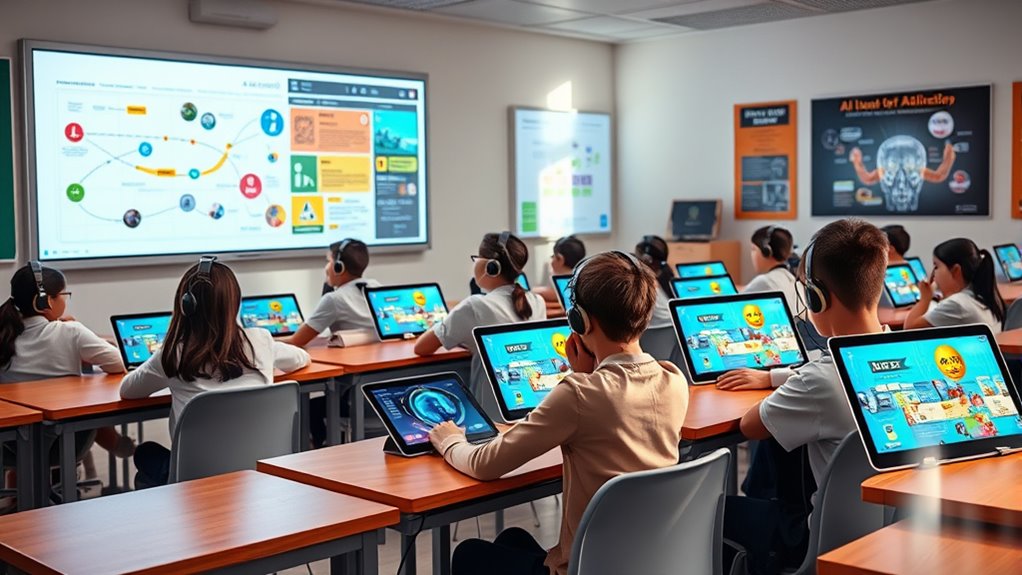As AI in schools accelerates, it’s vital to learn from past edtech issues like overhype, lack of equity, and insufficient teacher training. Many initiatives failed because policies lagged behind technology and didn’t consider all students’ needs. To succeed with AI, focus on responsible use, fairness, and educator support. If you want to understand how these lessons can help shape a better future for education, keep exploring the key insights ahead.
Key Takeaways
- Past edtech failures highlight the importance of aligning AI tools with pedagogy rather than technology for meaningful impact.
- Clear policies and ethical guidelines are crucial to prevent misuse and ensure responsible AI integration in schools.
- Addressing equity gaps is essential to prevent AI from widening educational disparities among underrepresented students.
- Investing in AI literacy for educators and students helps bridge the understanding gap and promotes effective use.
- Strategic, cautious implementation based on lessons learned from past missteps can maximize AI’s benefits and minimize risks.

Have you noticed how AI is transforming classrooms everywhere? It’s clear that AI adoption is accelerating rapidly, with 92% of students now using AI tools in their studies. This marks a huge jump from previous years, reflecting how integral AI has become. Students are increasingly turning to generative AI, like ChatGPT, for tests, with 88% admitting to its use—up from just 53% in 2024. This shift shows how AI tools are no longer optional but essential parts of learning routines. Schools are trying to integrate AI into classrooms, especially in K-12 settings, where educators promote responsible use. However, many schools struggle with creating clear policies on AI, particularly at the high school level, revealing a gap between technology adoption and policy development. There’s also concern about policy development and how it can keep pace with rapid adoption. There’s also concern about equity. AI risks widening educational gaps, especially for underrepresented students who may lack access or guidance. As AI’s role grows, so does the market. The global AI in education market hit $7.57 billion in 2025, growing 46% from the previous year, and projections estimate it will reach $112.3 billion by 2034. This growth is fueled by personalized learning tools and AI-powered collaboration platforms, which are becoming standard. Business leaders plan to increase AI investments, recognizing its potential to reshape education. Yet, despite these advancements, many students and teachers feel unprepared. Over half of students (58%) lack confidence in their AI skills, and only 17% of faculty have advanced AI literacy. This preparation gap leaves many institutions without extensive AI programs. Underrepresented groups, like first-generation students, often feel less confident in their AI capabilities, highlighting the need for equity-focused initiatives. In higher education, a notable 65% of students believe they know more about AI than their instructors, emphasizing the disconnect. Students see AI as a tool for personalized learning and creative projects, shifting from earlier concerns about cheating. Interestingly, the rapid adoption of AI in schools has also led to increased calls for responsible AI use and ethical guidelines. Still, schools face challenges in ethically integrating AI, ensuring it enhances learning rather than replacing traditional methods. Overall, the rapid rise of AI in schools offers incredible opportunities but also underscores the importance of learning from past edtech missteps—balancing innovation with equity, policy, and preparedness.
Frequently Asked Questions
How Can AI Personalize Learning Without Infringing on Student Privacy?
You can personalize learning with AI by using anonymized and aggregated data, ensuring individual identities stay protected. Implement strong encryption, secure storage, and edge computing to process data locally. Incorporate differential privacy techniques to add controlled noise, preserving privacy while enabling personalization. Also, involve students and parents in data choices through opt-in options and follow strict policies like FERPA. These steps balance effective personalization with robust privacy safeguards, fostering trust and better learning outcomes.
What Are the Costs Associated With Implementing AI in Schools?
Imagine building a digital bridge into your classroom—costs add up quickly. You’ll spend $15,000 to $20,000 on analytics tools, $7,000 to $15,000 on lesson planning, and around $15,000 on chatbots. Ongoing expenses include licensing, maintenance, and infrastructure upgrades, which can total hundreds of thousands annually. Plus, investing in training and data security is essential, making AI integration a significant financial commitment.
How Do Teachers Feel About AI Replacing Traditional Teaching Methods?
You might worry that AI could replace traditional teaching methods, but many teachers see it as a supportive tool rather than a replacement. While some fear losing the human touch or pedagogical identity, others appreciate AI’s potential to personalize learning and reduce workload. Overall, most teachers prefer integrating AI thoughtfully to enhance their teaching, but they want to maintain the essential human connection that defines effective education.
What Measures Ensure AI Tools Are Free From Biases?
Think of bias detection as steering a ship through turbulent waters—you need precise instruments. You should use unsupervised bias detection tools that identify anomalies without protected data, continuously test AI performance across diverse groups, and compare responses to varied inputs. Regularly audit with synthetic and real samples. Combining quantitative analysis with expert judgment, and involving diverse teams, helps *guarantee* your AI remains a fair and trustworthy navigator in education’s complex seas.
How Will AI Impact Equity Among Students From Different Backgrounds?
AI has the potential to improve equity among students if implemented thoughtfully. You can guarantee it supports diverse learners by providing personalized resources and tailored support, helping bridge achievement gaps. However, you’ll need to address access disparities and prevent biases in AI tools. By advocating for equitable policies, investing in teacher training, and monitoring AI fairness, you can make sure AI benefits all students regardless of their backgrounds.
Conclusion
Just like a ship steering choppy waters, you need to steer AI in schools with care and foresight. Learning from past edtech missteps, you’re better equipped to harness AI’s potential without getting lost in the fog. By staying vigilant and thoughtful, you can ensure AI acts as a guiding star rather than a sinking anchor, illuminating the path toward a smarter, more equitable education for everyone. The journey’s just beginning—trust your compass.











